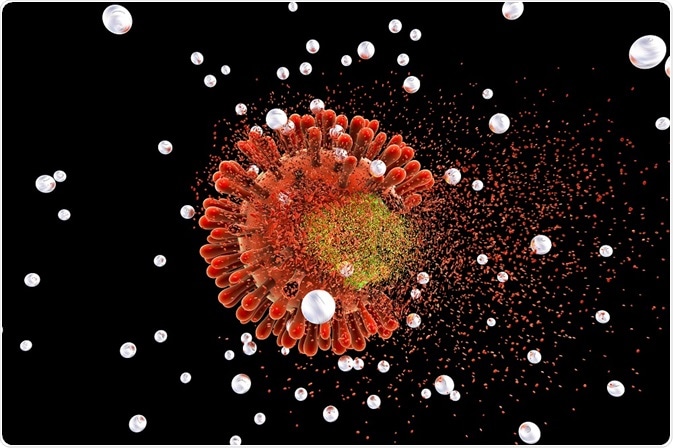
Silver Nanoparticles and HIV
Nanoparticles are gaining increasing importance in the biological sciences as sensors, labels for cells and molecules, and in therapeutics. Silver nanoparticles are of particular interest due to their special properties.

Credit: Kateryna Kon/Shutterstock.com
Silver nanoparticles are ideal candidates for molecular labeling because phenomena such as surface-enhanced Raman scattering can be taken advantage of. Silver is also strongly toxic to a range of organisms, and silver nanoparticles are widely used as an antimicrobial material.
Nanoparticles have a large surface area that can come into contact with bacteria and viruses, so it is more efficient in its effect than larger particles. The antimicrobial efficacy of nanoparticles is also dependent on the size and shape of the particle. This is partly because the shape of the nanoparticle determines how much silver it contains. Generally, rods have a higher amount of silver than spheres, and spheres hold more silver than pyramids.
Generally, the smaller the size of the nanoparticle, the more interaction and inhibition can take place. Smaller nanoparticles penetrate the host cell and then block factors within the cell or viral vectors. They can also become attached to the viral genome, preventing viral polymerase activity.
HIV
It is estimated that 5-78% of patients treated with HIV-1 are resistant to antiretroviral therapy. This gap in effectiveness created by the emergence of resistance creates a need for new anti-HIV agents to cover different stages of the viral life cycle. Silver nanoparticles have antiviral activity against HIV-1.
HIV is a lentivirus, and a member of the Retroviridae family. It causes acquired immunodeficiency syndrome (AIDS). There are two forms of HIV, HIV-1 and HIV-2. The outer part of HIV-1 is a lipid membrane with projecting glycoprotein knobs formed by envelope proteins gp120 and gp41. The main function of gp120 is binding with the CD4 receptor protein on host cells.
In one study, silver nanoparticles showed antiviral activity against HIV-1 resulting from their interaction with envelope glycoprotein gp120, preventing CD4-dependent virion binding, fusion, and infectivity.
The nanoparticles were also able to block HIV-1 cell-free and cell-associated infection. This mode of interaction allowed the silver nanoparticles to inhibit HIV-1 regardless of how the virus is attached to the cell or its resistance profile.
Capping agents
The properties of nanoparticles vary depending on their capping agent. Capping agents are materials that form a layer on the surface of a nanoparticle in order stabilize it.
When foamy carbon, poly (N-vinyl-2-pyrrolidone), and bovine serum albumin were tested as capping agents for silver nanoparticles, the foamy carbon appeared to have the greatest inhibitory effect on viral replication. However, this preparation also had greater cell toxicity. The antiviral properties of silver nanoparticles can be enhanced by adding a drug or therapeutic molecule.
Alternative uses of silver nanoparticles
An interesting alternative application of the antiviral properties of silver nanoparticles against HIV is their use in prophylactic devices, rather than as a therapeutic in already-infected patients. Researchers from the University of Manitoba soaked condoms in a solution of silver nanoparticles and found that they killed all HIV and herpes viruses in the samples.
Reviewed by Liji Thomas, MD.
Sources:
- Interaction of silver nanoparticles with HIV-1
- Inactivation of microbial infectiousness by silver nanoparticles-coated condom: a new approach to inhibit HIV- and HSV-transmitted infection
- Application of silver nanoparticles in viral inhibition: a new hope for antivirals
- Mode of antiviral action of silver nanoparticles against HIV-1
Further Reading
Last Updated: Apr 23, 2018























.png)











No hay comentarios:
Publicar un comentario